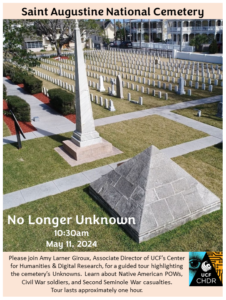- There are no upcoming events.
- There are no upcoming events.
- Venues
- Venues
- St. Augustine National Cemetery
 Although the St. Augustine burial ground was not designated a national cemetery until 1881, this hallowed site played a vital role in the colorful history of the oldest city in the nation. St. Augustine was originally established in the 17th century as a Spanish colonial possession. The land that is now a national cemetery was part of a Franciscan monastery, and the southern boundary marks the periphery of the old Spanish-walled city. During England’s rule of Florida from 1763 to 1783, the monastery was occupied by the military. During the second Spanish occupation of Florida, from 1783 to 1821, the property remained in the hands of the military.
Although the St. Augustine burial ground was not designated a national cemetery until 1881, this hallowed site played a vital role in the colorful history of the oldest city in the nation. St. Augustine was originally established in the 17th century as a Spanish colonial possession. The land that is now a national cemetery was part of a Franciscan monastery, and the southern boundary marks the periphery of the old Spanish-walled city. During England’s rule of Florida from 1763 to 1783, the monastery was occupied by the military. During the second Spanish occupation of Florida, from 1783 to 1821, the property remained in the hands of the military.
When the United States gained possession of Florida in 1821, the old fort barracks was set aside for a post cemetery. According to historical records, the first interment took place in 1828. Most early burials were soldiers who died during the “Indian War,” either in battle or due to sickness and disease—not uncommon in Florida’s subtropical climate. The native Seminoles resisted the U.S. government’s attempts to forcibly remove them from their territory and seven years of fighting ensued.
On December 23, 1835, Maj. Francis L. Dade and his company were ordered to reinforce Gen. Wiley Thompson’s troops stationed at Fort King, Ocala. During the trek from Tampa to Fort King, Dade, believing there was no threat as they passed through Seminole-controlled territory, failed to take appropriate precautions. The heavy winter garments of the soldiers covered their weapons, so that when the Seminoles staged an attack, Dade’s troops were virtually wiped out—only two or three soldiers survived. A few months later, when travel in the area was again possible, the massacred soldiers were buried at the site.
Monuments and Memorials
The Dade Monument is composed of three pyramids constructed of native coquina stone and originally covered with white stucco. The pyramids were dedicated at a ceremony on August 15, 1842, that marked the end of the Florida Indian Wars. The structures cover vaults that contain the remains of soldiers who died during the Florida Indian Wars (1835–1842). According to the inscription, the wars began on December 25, 1835. Three days later, Maj. Francis L. Dade and his regiment were enroute from Fort Brooke (Tampa) to Fort King (Ocala) when they were ambushed and killed. Of the 108 men and officers under his command, only two or three survived. Maj. Dade and his men are among those entombed at the pyramids.
The Dade Monument, a coquina stone and marble obelisk, was erected in 1844 and commemorates Maj. Francis L. Dade and the men who died with him at the 1835 massacre. Soldiers stationed at the St. Augustine post contributed one day’s pay to fund the memorial.

